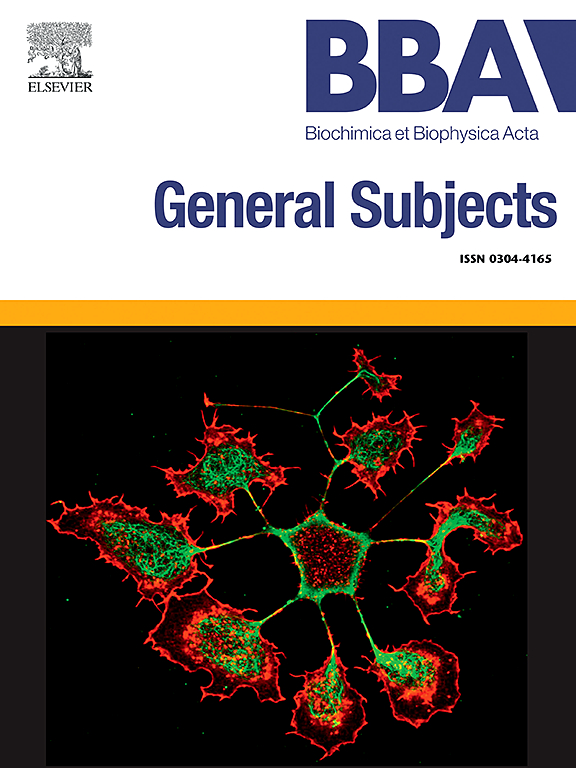Redox modulation via a synthetic thiol compound reshapes energy metabolism in endothelial cells and ameliorates angiogenic expression in a co-culture study with activated macrophages
IF 2.2
3区 生物学
Q3 BIOCHEMISTRY & MOLECULAR BIOLOGY
Biochimica et biophysica acta. General subjects
Pub Date : 2025-04-03
DOI:10.1016/j.bbagen.2025.130803
引用次数: 0
Abstract
The vascular endothelium is the first interface exposed to circulating compounds and oxidative as well as pro-inflammatory stimuli. Nowadays, cysteine pro-drugs are emerging as new and potential therapies in cardiovascular and inflammatory diseases due to their cytoprotective effects. In this study, the effects of redox modulation by a synthetic thiol compound, i.e., I-152, a precursor of N-acetylcysteine (NAC) and cysteamine (MEA), were evaluated after 6 h and 24 h treatment on human umbilical cord endothelial cell (HUVECs) energy metabolism. Following I-152 treatment, higher cysteine and glutathione (GSH) content were detected via HPLC, in concomitance with I-152 derivatives, i.e., NAC and MEA. Untargeted metabolomics confirmed GSH upregulation and NAC presence in addition to I-152 itself and other metabolites, such as dithiol compound (NACMEAA) and triacetylated I-152. Mass spectrometry revealed that I-152 boosted ATP production, specifically through the mitochondrial OXPHOS, as determined via Seahorse assay without inducing oxidative stress. Additionally, I-152 treatment of HUVECs before co-culture with LPS-stimulated macrophages provided GSH and cysteine sustainment and attenuated the transcription of adhesion molecules as well as iNOS expression. Identifying the impact of redox regulation in physiological conditions and the possible metabolic targets could aid the application of novel thiol-based therapeutics.

在一项与活化巨噬细胞共培养的研究中,通过合成硫醇化合物进行氧化还原调节,重塑内皮细胞的能量代谢并改善血管生成表达
血管内皮是暴露于循环化合物和氧化以及促炎刺激的第一个界面。目前,半胱氨酸前药因其具有细胞保护作用而成为治疗心血管疾病和炎症性疾病的新疗法。在本研究中,研究了n -乙酰半胱氨酸(NAC)和半胱氨酸(MEA)前体I-152对人脐带内皮细胞(HUVECs)能量代谢的氧化还原调节作用。在I-152处理后,通过HPLC检测到较高的半胱氨酸和谷胱甘肽(GSH)含量,并伴有I-152衍生物,即NAC和MEA。非靶向代谢组学证实了GSH上调和NAC的存在,除了I-152本身和其他代谢物,如二巯基化合物(NACMEAA)和三乙酰化I-152。质谱分析显示,通过海马测定,I-152促进了ATP的产生,特别是通过线粒体OXPHOS,而不会引起氧化应激。此外,在与lps刺激的巨噬细胞共培养前,对HUVECs进行I-152处理,可以维持GSH和半胱氨酸,并减弱粘附分子的转录和iNOS的表达。确定氧化还原调控在生理条件下的影响和可能的代谢靶点有助于新型巯基治疗方法的应用。
本文章由计算机程序翻译,如有差异,请以英文原文为准。
求助全文
约1分钟内获得全文
求助全文
来源期刊

Biochimica et biophysica acta. General subjects
生物-生化与分子生物学
CiteScore
6.40
自引率
0.00%
发文量
139
审稿时长
30 days
期刊介绍:
BBA General Subjects accepts for submission either original, hypothesis-driven studies or reviews covering subjects in biochemistry and biophysics that are considered to have general interest for a wide audience. Manuscripts with interdisciplinary approaches are especially encouraged.
 求助内容:
求助内容: 应助结果提醒方式:
应助结果提醒方式:


